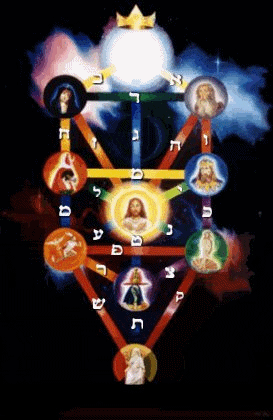On May 13, 2006 new Mystery School member from the Netherlands, Gilraen, writes:
I have a question about the sign of the cross, and specifically about the words that go with it. Not the English words but the other ones. I’m thinking they’re Hebrew, at least the text seems to suggest they are. But if I look up the Lord’s Prayer in Hebrew, the words are different. Why is this? It’s the same text, right? So aren’t these words Hebrew or is there another difference?
Katia writes back:
Hail Gilraen:

Yes, they are all Hebrew words. The problem is that the Lord’s Prayer doxology part (“for thine is the kingdom, the power and the glory”) is what we want to be reciting when we touch corresponding spheres on the Tree of Life. Because the Tree of Life spheres each have so many different names, it makes things confusing. In the early 1900’s, when the Golden Dawn Kabbalists designed the Kabbalistic Sign of the Cross, they went with the two middle spheres Geburah (Judgement or Strength) and Hesed (Mercy or Love, sometimes spelled Chesed). Hesed is also called Gedulah, the latter meaning Magesty/Greatness and Glory in Hebrew, even though a lower sphere, Hod, definitely means Glory! Anyway, as a result of choosing those slightly higher spheres, Geburah and Gedulah, they ended up saying, For thine is the kingdom, and the judgement and the magesty/glory.
Note added 2022: Geburah / Gevurah in Hebrew literally means “Strength”, as in Gabriel’s name “Strength of God”. So it can definitely be translated as Power. So the Golden Dawnies had it somewhat correct, “For thine is the Kingdom, and the strength and the magesty/greatness”.
To correspond to the Lord’s prayer we are supposed to say the names of the two spheres BELOW Geburah & Hesed when we touch our shoulders. Those two lower spheres are
1. “Power” (aka Victory, endurance, eternity, which is Netzach in Hebrew) and
2. “Glory” (Hod). [Blinking spheres shown on right] Those spheres make better sense in some ways. Yet, the Golden Dawn kabbalistic cross creators want the Hebrew words in there, v’Geburah (and the power/strength) & v’Gedulah (and the glory/magesty). The Golden Dawn is considered “the” authority on making the sign of the Kabbalistic Cross, so I deferred to their tradition when we put it in the first lesson. But I often think we should change it. NOTE added 2022: Perhaps to v’Gevurah v’Tiferet, as translated here: Hebrew Lord’s Prayer . Tiferet can be translated as “glory, splendour or beauty”.
Back to 2006: I just gave a lecture this past Sunday in North Hollywood, CA (May 2006!) where I taught making the sign of the cross while touching parts on the body that correspond to the Tree of Life’s spheres. I had Tipharet for the forehead instead of Crown, then Kingdom for abdomen as usual. But I do Netzach and Hod for Power and Glory. I use the lower spheres Netzach and Hod because we are symbolically kneeling at the base of the Tree when we “touch” those spheres on our body. Later, we stand up and wear the Crown at the top. By the way, when we are symbolically standing up, we can touch other spheres at our shoulders because our shoulders are now “higher”, no longer are we kneeling. I know it sounds goofy, but it’s pretty cool. Especially when you “touch” the two top spheres, Wisdom and Understanding, the latter of which is also called Marah one of whose meanings is “beloved” in ancient Egyptian. So you are saying, for thine is the Beauty (Tipharet becomes the abdomen sphere, not Malkut anymore), the Sophia (Hokmah), and the Beloved (Binah). You are talking to the Divine Feminine.
Actually, and this was the point of my lecture last week, we are already possibly talking to the Divine Feminine when we say the doxology ending part of the Lord’s Prayer. This is because Power can be the Goddess Shakti and Allah’s daughter-goddess Uzzah (Arabic, Aramaic, Hebrew for Power), and Glory can be translated as Shekinah, known as the “Glory of God”. Kingdom is already a feminine word, Malkut, also known as the “daughter”.
Back to that Catechumen Lesson 1. Perhaps we should change the v’Gedulah and v’Geburah to the proper Hebrew syllables.
2022 NOTE: Technically, v’Geburah (or v’Gevurah) is correct, meaning “and the power”. And v’Gedulah does mean “and the magesty/greatness” which is a form of glory in kingship. I recently read (2022) that in the Aramaic language of Jesus the words “and the glory” was sometimes translated as “and the songs”. Now that is cool. “For thine is the kingdom, and the power, and the songs, now and forever.”
In 2006 when I originally wrote this, I wondered if “li-olam” might not mean “forever” exactly. NOTE ADDED July 2022: Later study and consultation with Hebrew scholars reveals that li-olam in Hebrew is best rendered l’olmey ola-meem and means “forever and ever”. The Aramaic translations of the Lord’s Prayer Doxology (final portion) translate those final words as “Now and forever” or “age unto ages”.
See this nice Learn the Lord’s Prayer in Hebrew video on YouTube
It’s interesting to note that Jesus / Yeshua did NOT give this prayer to his students in Hebrew. He taught it to them in Aramaic, the everyday language in the Middle East in Jesus’ time. Early church legends believe he or some of his followers put the tune to music. There is a 1600 year old hymn called the Syriac Lord’s Prayer, which some believe is the original melody. If you watch this video Syriac Orthodox Prayer “Abun D’Bashmayo” (The Lord’s Prayer) the second half contains the Syriac (Syrian Aramaic) words sung to music. The first half is spoken only, you must wait for about halfway to get to the ancient Syriac hymn.
